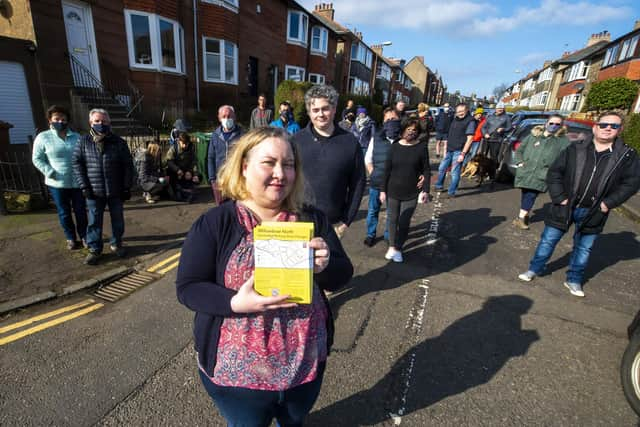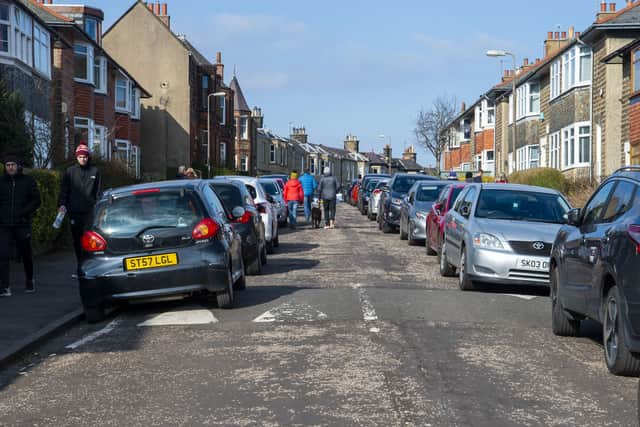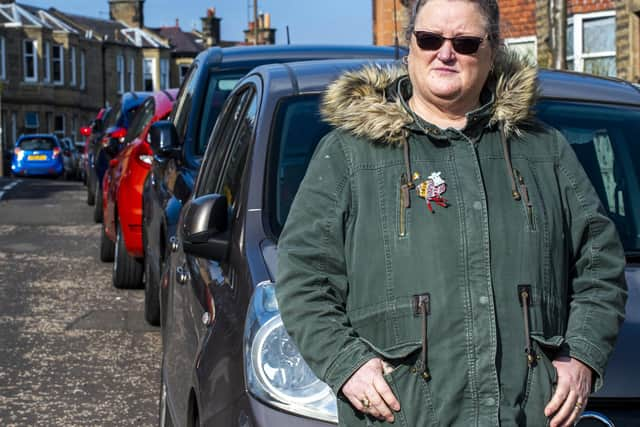Edinburgh's parking problems: The Good, The Bad and The Urbanist Agenda
and live on Freeview channel 276
Willowbrae North is a perfect picture of the good, the bad and the ugly sides of the new Controlled Parking Zones which are about to park on your doorstep. Here Josie Balfour tells us why her street is fighting against the council’s plan to impose double yellow lines, permits and pay and display.
The Good
Not for the first time, I’m wondering if there’s a body in the car parked opposite my house. It’s been there for weeks and is full of bedding. Maybe someone parked up for the night in the cold weather, fell asleep and never woke up?


Advertisement
Hide AdAdvertisement
Hide AdIf the new citywide Controlled Parking Zone (CPZ) proposals go through this year, then a mysterious car on the street will be a moot point. Instead of trying to think up reasons to get the police to pop by and make sure all’s well, I could call up the council and tell them someone without a parking permit was taking up valuable space. One of the great benefits of living in a CPZ is that dumped vehicles will be a thing of the past; so too will be campervans and work vans with sides higher than 2.5 meters.
Certainly, it’s one of the reasons many people in the newly designated CPZ area of Willowbrae North aren’t averse to paying for a permit in order to make sure that their streets are protected from dumped cars and campervans.
Living in a tenement flat on Queens Park Avenue, teacher Claire Wilson is looking forward to living in a CPZ. She says: “My parents are over in Marchmont and permits made a huge difference. They weren’t happy paying for it [a permit] at the beginning, but a lot of their problems with the hospital staff and the students and people going down the Meadows all parking on their street got sorted out.
“It’s the same here, before Covid, you used to get loads of people parking all over on Meadowbank and Meadowbank Crescent, all along the roads first thing in the morning and then going to work at the likes of St Margaret’s House or into town. It’s not fair on the people that live here to be pushed out like that. If it’s true that they want to extend the restrictions to a Saturday too, I’m all for that”.


Advertisement
Hide AdAdvertisement
Hide AdCouncillor John McLellan is also keen to promote the benefits of introducing a CPZ in Willowbrae North. He sees it as a necessity to prevent the knock on effect of more commuters parking in the area when Abbeyhill becomes a CPZ in the coming year.
Over the phone, he speaks about the serious parking tensions that have dogged Abbeyhill for years, saying: “My views are that people in Abbeyhill have been putting up with difficult parking conditions for sometime. Two years ago, I even had an incident where an elderly lady was sworn at by a morning commuter for not leaving her parking spot quick enough. “
While he’s sympathetic to his constituents in Willowbrae North, particularly those who have lived in the area for forty or fifty years without a problem, he says: “ I, and my fellow councillors, have full inboxes over this. No one has said they’re opposed to having permits, they’re more concerned about being able to access parking space.
We know that there is enough capacity to accommodate car ownership in the area, so I am working to make sure residents’ amenity is not adversely affected by these changes.”


The Bad
Advertisement
Hide AdAdvertisement
Hide AdUpon finding out that the council doesn’t make money from car parking permits, at an online public consultation last Wednesday, one wag piped up; “Well you’re more incompetent than I thought”.
It was one among many angry barbs thrown at a long suffering panel of council parking planners consulting with the residents of Willowbrae North on the Controlled Parking Zone changes that they want to implement. And not just in this area but 31 others too, the scope of the four phase plan extending from Trinity to Portobello and from Roseburn and Gorgie to the edge of South Gyle.
Many of these areas are being targeted with permit parking, pay and display bays and double yellow lines in order to put an end to commuters and tourists parking in residential areas along the ‘A8 corridor’ and then taking public transport or walking into town.
While it’s a priority for councillors and city planners to decongest the city, the residents of Glenlee Gardens and Glenlee Avenue are the most vocal in their opposition to the changes in Willowbrae North. Myself among them. In part because both streets will lose 50% of their parking space to double yellow lines as they’re approximately 30 cm too narrow to warrant parking bays on both sides of the road.
Advertisement
Hide AdAdvertisement
Hide AdWithout the introduction of a CPZ, they’d likely be left as they are.
When an innocent council leaflet about a CPZ consultation flopped through the letterbox at the end of February, most of us gave it a quick glance and put it aside. It wasn’t until a neighbour followed the link on the leaflet that we discovered just how much parking space the area would lose.
We shared the information over social media and discovered that no one we spoke to in the tenements on Meadowbank Crescent or Queen’s Park Avenue had been made aware of the changes, nor had many others on affected streets. So the residents of Glenlee Gardens made a leaflet of their own, with the full online map of proposed changes and distributed it throughout the neighbourhood in as Covid safe a manner as possible.
We added in a survey too, to see what residents were using their cars for so that we could share the information with our local councillors in the hope of finding a better solution to congestion in the area than a CPZ.
Advertisement
Hide AdAdvertisement
Hide AdOn Glenlee Avenue, they wrote and co-signed letter to their local councillors and on Willowbrae Avenue someone started a petition.
And then the residents of Willowbrae North found themselves at two boisterous consultation meetings, where claims of council cash grabs were shot down with statistics (only 50% of the cost of vehicle permits is covered by the permits themselves, the rest is made from pay and display and fines); and where the admission was made that the council can’t tell us how much permits will cost because they’re currently reviewing the payment bands.
It seems that for local residents the issue isn’t just about losing half of our on street parking, it’s anger about poor communication from the council.
The city wide ‘Strategic Parking Review’ was approved in 2018, yet city officials can’t tell residents how many permit parking spaces are available in their area - just that it’s legal for the council to offer every household two permits, even though it looks like Willowbrae North will lose a minimum of 40 parking spaces or 6% of parking space (out of 740 spaces, according to one resident who went out with a yardstick early on a Sunday morning, while another resident claims we could lose upto 17% of our parking spaces judging by the map measurements).
Advertisement
Hide AdAdvertisement
Hide AdThis will not be an issue at the top of Lily Hill and Willowbrae Avenue, with broad roads and large houses. It will, however, affect those living in crowded tenements at the bottom of the hill on London Road and Meadowbank Crescent where parking is already at a premium. With the imminent arrival of parking free student flats and family accommodation opposite Meadowbank Stadium, as well as new parking restrictions in Abbeyhill, the council are unable to provide residents with any information about the knock on effect this will have on congestion in Willowbrae North. All they can say is that permit parking will protect the neighbourhood from the worst problems and commit to reviewing plans for Glenlee Avenue and Glenlee Gardens.
The consultation also raised the thorny issue of rat run shortcut Paisley Crescent.
Although Paisley Crescent is just outside the proposed CPZ area, it is the main route that children in Willowbrae North take to school in the morning. A steep road with a blind corner, often used as a shortcut by early commuters, the street has dazzlingly low light in the winter mornings. Very young children are often forced to walk up the middle of the road to school because the pavements are too icy to traverse. Anyone parking there with summer tyres in the winter is an active danger to themselves and others, as evidenced by the dents in the bollards where the Lollipop lady Irene Courtney helps children cross every morning.
The average take up of permits in a CPZ area is 60%, which begs the question, where are people who can’t afford to buy a permit going to park? For the residents of Willowbrae North, the answer would preferably not be Paisley Crescent.
Advertisement
Hide AdAdvertisement
Hide AdWith only a few days to go before consultation in this area closes on March the 14th, it seems that residents have won a review of their streets but the overall tone of the consultation is that the introduction of a CPZ is inevitable.
The Ugly
As regular readers will know, the City of Edinburgh Council has been pushing for a solution to reducing daily car journeys in the city for more than twenty years. After the wholesale rejection of a two tier city road toll by locals in 2002, which could have netted the council as much as £1.2 billion a year in congestion charges and reduced daily car journeys by as many as two thousand a week, a series of other measures have been introduced to limit cars in the city, including the new pedestrianisation of George Street. (https://www.edinburghnews.scotsman.com/news/politics/council/edinburgh-businesses-claim-there-little-support-george-street-pedestrianisation-council-insists-it-could-shut-all-traffic-1367275)
In a Valentine’s Day love letter to the city in this paper, Transport and Environment Committee Convenor Councilor Lesley McInnes outlined her commitment to the city becoming carbon neutral by 2030. In that article she acknowledged that in Edinburgh: “Households spend most on transport after housing (approximately £80 weekly per household) and this is a heavy burden for many families.”
(https://www.edinburghnews.scotsman.com/news/opinion/columnists/edinburgh-can-be-shining-example-how-create-cleaner-healthier-transport-system-lesley-macinnes-3133273).
Advertisement
Hide AdAdvertisement
Hide AdYet by introducing a city wide permit scheme with band pricing based on vehicle emissions, it seems that the poorest in the city will bear the financial brunt of the council’s efforts to be carbon neutral. It is not the people with private driveways and the newest cars that are affected by this plan. It is the people that are driving older vehicles and living on narrow streets or in tenements, and often that means people on lower incomes.
The survey the residents of Glenlee Gardens sent out found two key things; firstly, that only a minority of respondents used their vehicles to travel into Edinburgh. Often residents use their vehicles to go out of town because public transport infrastructure doesn’t flow effectively in the area. It’s a 15 minute journey to get to Princes Street by bus from Willowbrae North, but going into town to change buses adds extra time to many local commuters’ journeys.
One teacher I spoke to explained that she would have an 80 minute one-way commute to work by public transport, by car it’s 20 minutes. For an NHS worker commuting to the Edinburgh Royal Infirmary, it’s 15 minutes by car and 45 minutes by bus.
And secondly, that the number one reason people (80% of respondents) used their vehicle was to visit friends and family. In the middle of a pandemic, where people haven’t seen their relatives in months and are experiencing extreme levels of poverty; the council are asking people to pay extra for parking on their own streets or give up the means by which they have to visit loved ones. It looks as if this city wide consultation may well backfire on the council as seriously as the 2002 congestion charge, no matter how well intentioned their plans.
A message from the Editor:
Thank you for reading this article. We're more reliant on your support than ever as the shift in consumer habits brought about by coronavirus impacts our advertisers.
If you haven't already, please consider supporting our trusted, fact-checked journalism by taking out a digital subscription.
Comment Guidelines
National World encourages reader discussion on our stories. User feedback, insights and back-and-forth exchanges add a rich layer of context to reporting. Please review our Community Guidelines before commenting.